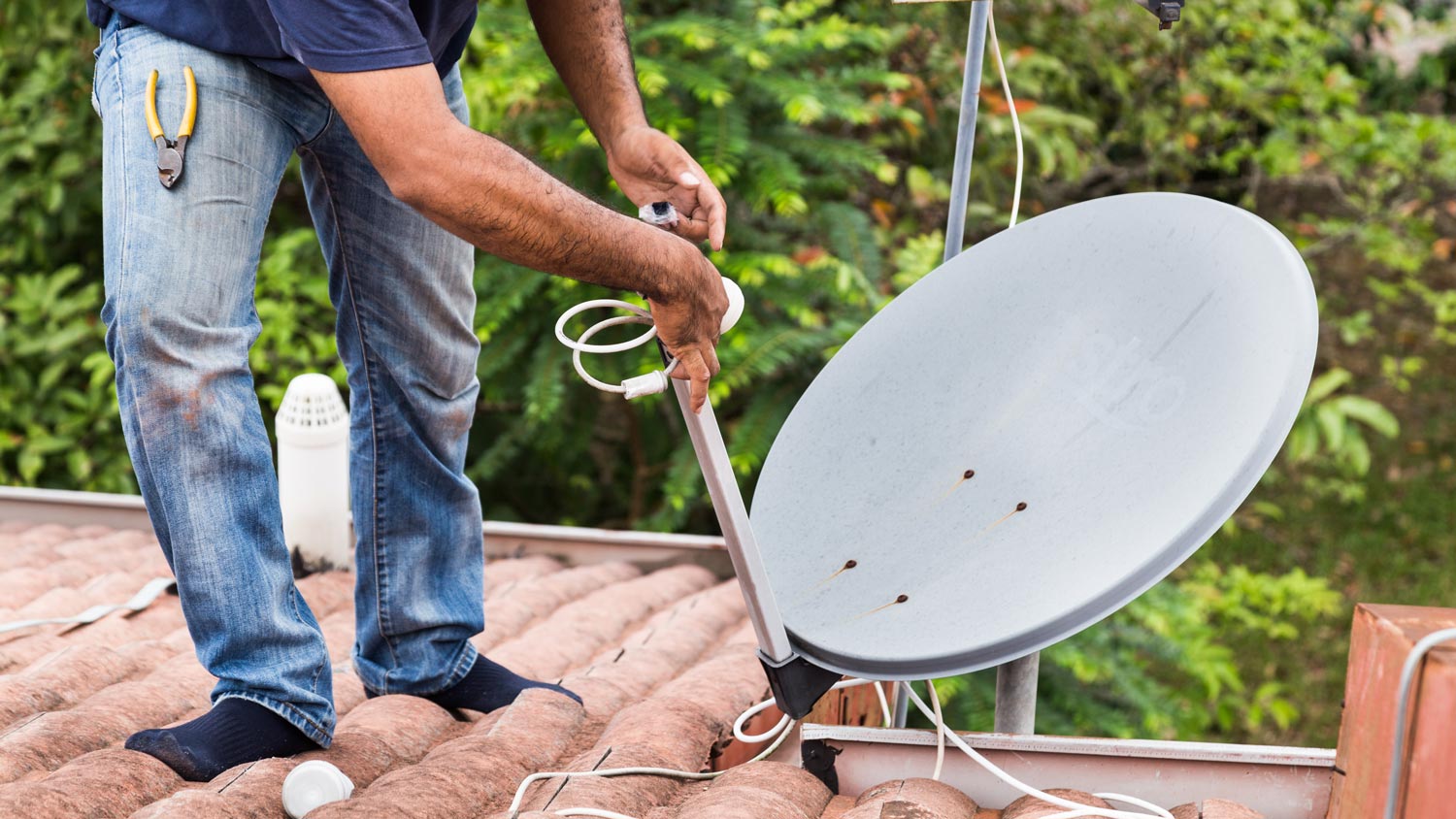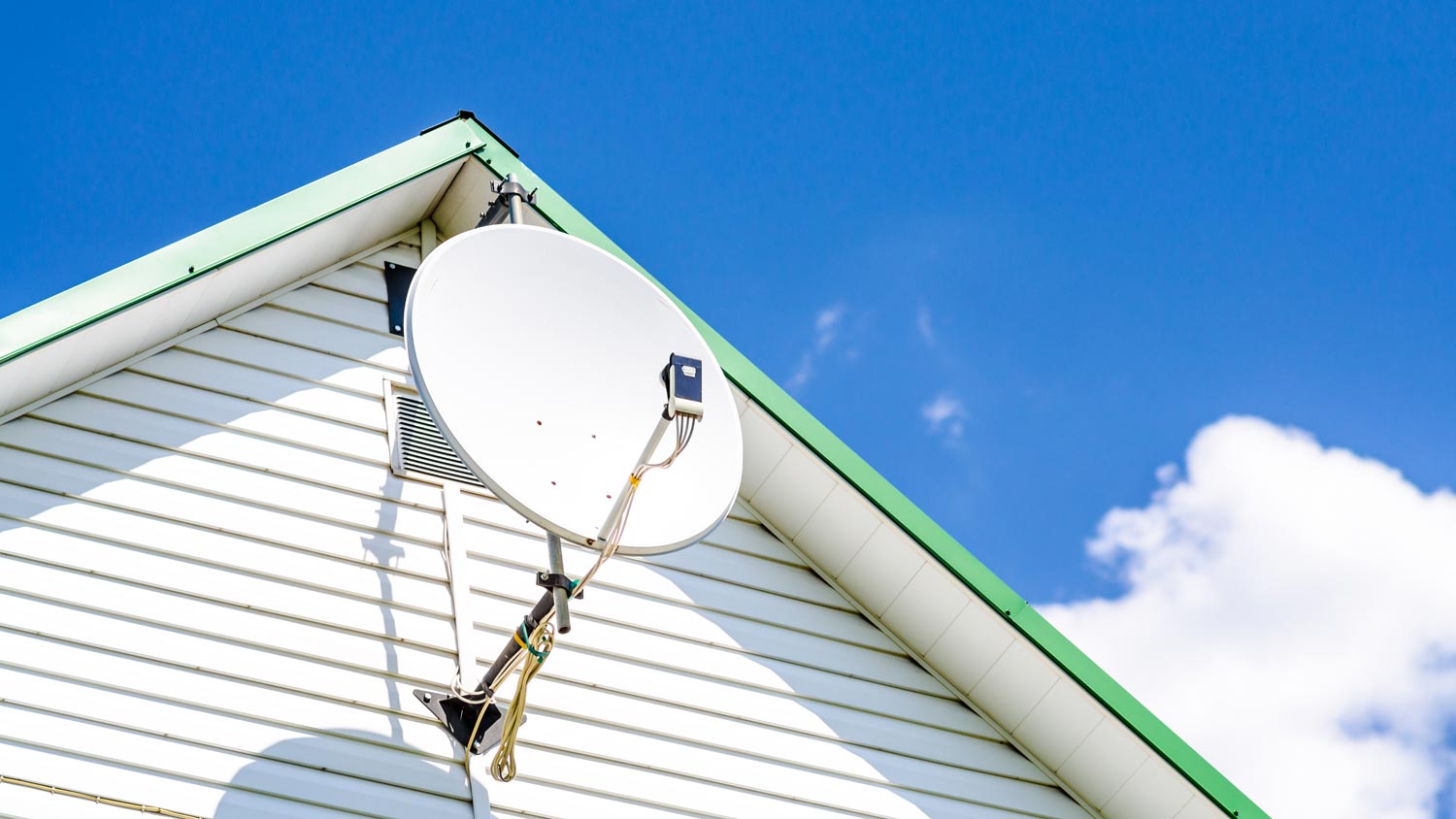
Find out the average satellite dish removal cost, including average prices, what factors affect pricing, and tips on how to save money on your project.
Most satellite dish repairs cost between $90 and $160, depending on the type of repair, labor rates, and replacement parts. Learn what impacts your satellite dish repair cost and how to save.


Satellite dish repairs restore signal quality and extend system life.
Common satellite dish repairs include realignment, cable replacement, and LNB fixes.
Labor rates, repair type, and dish model impact your total costs.
Regular satellite dish maintenance can help prevent costly repairs.
Professional repairs cost $50 to $100 per hour and ensure safety and optimal performance.
This article was created using automation technology and thoroughly fact-checked and edited by an Angi Editor in accordance with our AI policy.
The cost of satellite dish repair ranges from $50 to $1,100, with most homeowners paying an average of $130 for standard repairs. Prices depend on the type of repair, labor rates, and parts needed. Understanding these costs helps you budget for restoring your satellite TV or internet service quickly and efficiently.
Let’s explore what goes into these costs and how you can make the best choices for your home’s connectivity.
Several factors influence the cost of repairing your satellite dish. Knowing what affects pricing helps you understand where your money goes and how to plan for repairs.
Different types of satellite dish repairs come with their own urgency and price tags. Some repairs, such as realignment, are quick fixes, while others, like LNB replacement or cable repair, involve more labor and parts. The type of problem you’re facing will be the biggest driver of overall repair cost.
Dish realignment corrects your satellite’s aim to restore a clear signal. Misalignment can happen due to strong winds, heavy storms, or accidental bumps. Realignment is essential if you’re experiencing signal loss or pixelation, and it’s a routine fix for many homes, especially after severe weather.
The LNB is the component that receives the satellite signal and sends it to your receiver. If you notice persistent signal issues, pixelated images, or total signal loss, a faulty LNB might be to blame. LNB failure is not rare, especially in older systems or harsh climates.
Cables are vital for transmitting the signal from your dish to your receiver. Common issues include fraying, weather damage, or animal chewing. Cables may need repair or replacement every few years, especially if exposed to the elements. Expect to pay an average of $50 for simple cable repairs.
Mounting hardware keeps your dish stable and safe. Rust, loosened bolts, or storm damage can compromise the hardware, leading to poor signal or even a falling dish. Addressing these issues is urgent to maintain safe and effective operation.
Sometimes, the dish itself is cracked, warped, or too damaged to repair. Full or partial dish replacement is less common and often happens after major storms or accidents. Dish replacement costs range depending on the dish type and installation complexity. If you don’t want to install a new dish, you’ll have to pay a fee for dish removal.
Repair costs can vary based on the type of dish you have. Residential dishes are often less expensive to repair than larger commercial or high-tech models. Fixed dishes are simpler, while motorized or multi-satellite systems require more expertise and time.
The brand of your satellite dish can influence repair costs. Some brands use proprietary parts or have limited technician availability, which can make repairs more expensive. For example, DIRECTV, DISH Network, and HughesNet are common brands with varying repair costs based on their hardware and support networks. DIRECTV and DISH Network repairs often fall within the standard range, while specialized brands or imported systems may cost more due to part availability.
Dish size affects both the complexity and cost of repairs. Smaller “mini-dishes” are easier and quicker to repair, while large parabolic dishes require more time and may involve additional labor for access and adjustments.
| Dish Size | Description | Average Repair Cost |
|---|---|---|
| Mini-dish | Compact, residential | $75–$180 |
| Standard size | Most common for homes | $100–$300 |
| Large parabolic | Commercial or rural, wider diameter | $200–$600 |
Satellite dishes are made from various materials, which affects their repair costs. Aluminum dishes are lightweight and resistant to rust, making them easier and less costly to repair. Steel dishes are durable but can rust, increasing both repair frequency and cost. Composite dishes are sturdy but may require specialized parts.
Many satellite dishes come with manufacturer or installer warranties that can offset repair costs. Warranties often cover parts, labor, or specific repairs for a set period. Before paying out of pocket, check if your dish is still under warranty—this could save you the cost of common repairs or even a full replacement.
Some service providers and installers offer maintenance plans for satellite dishes. These plans include regular inspections, cleaning, and minor repairs. Over time, having a maintenance plan can save you money by catching issues early and reducing the need for emergency or major repairs.
Satellite dish repairs are performed by specialized technicians, electricians, or general handypersons. Labor can be charged hourly (ranging from $50 to $100 per hour) or as a flat fee for standard services.
Rates vary by region and company type, with larger companies or certified technicians sometimes charging more. More complex repairs or installations that are difficult to access may increase labor costs.
Where you live and where your dish is installed can affect repair pricing. Urban areas may have higher labor rates but easier access to technicians. Rural locations might incur travel charges. The placement of your dish—on a roof, wall, or pole—also impacts cost, as hard-to-reach spots require more time and equipment.
Some satellite dish repair jobs require or benefit from add-ons. Installing a signal booster, upgrading your system, or replacing a surge protector costs most homeowners between $30 and $150. These services are recommended if your system is outdated or if you’ve had recurring issues with signal strength or electrical surges.
Choosing between repairing and replacing your satellite dish depends on several factors. If your dish is relatively new, under warranty, or the damage is minor, repair is the logical choice.
If your satellite dish is old, has frequent issues, or the repair cost approaches or exceeds 50% of the price of a new dish, replacement is often the smarter investment. For example, if a new dish costs $300 and your repair would be $180 or more, replacing it may provide better long-term value. Upgrading to a newer model can also improve signal quality and reliability, especially if your current dish struggles with modern services.
DIY satellite dish repairs can save you money on labor, but they come with risks. You’ll need basic tools, replacement parts, and a sturdy ladder if the dish is mounted high. Simple tasks, such as realignment or cable replacement, might cost $20 to $80 in parts, while professional repairs for the same issue run $75 to $180.
However, working on a roof or handling electrical components can be dangerous without the right skills and safety equipment. Attempting complex repairs yourself may void warranties or cause further issues, leading to higher costs down the line. For anything involving roof access, electrical work, or advanced troubleshooting, it’s best to hire a local satellite dish repair technician.
Here are a few helpful ways to keep satellite dish repair costs within budget:
Schedule regular inspections to catch issues early.
Compare multiple quotes from qualified technicians.
Check warranty coverage before authorizing repairs.
Perform basic maintenance tasks, such as debris removal and visual inspections.
Bundle repairs with other home services for possible discounts.
Consider maintenance plans for long-term savings.
Avoid emergency service calls by planning repairs during regular hours.
Home is the most important place on earth, which is why Angi has helped more than 150 million homeowners transform their houses into homes they adore. To help homeowners with their next project, Angi provides readers with the most accurate cost data and upholds strict editorial standards. We extensively research project costs to develop the pricing data you see, so you can make the best decisions for you and your home. We rely on reputable sources, including the U.S. Bureau of Labor Statistics, academic journals, market studies, and interviews with industry experts—all to ensure our prices reflect real-world projects.
Want to help us improve our cost data? Send us a recent project quote to [email protected]. Quotes and personal information will not be shared publicly.